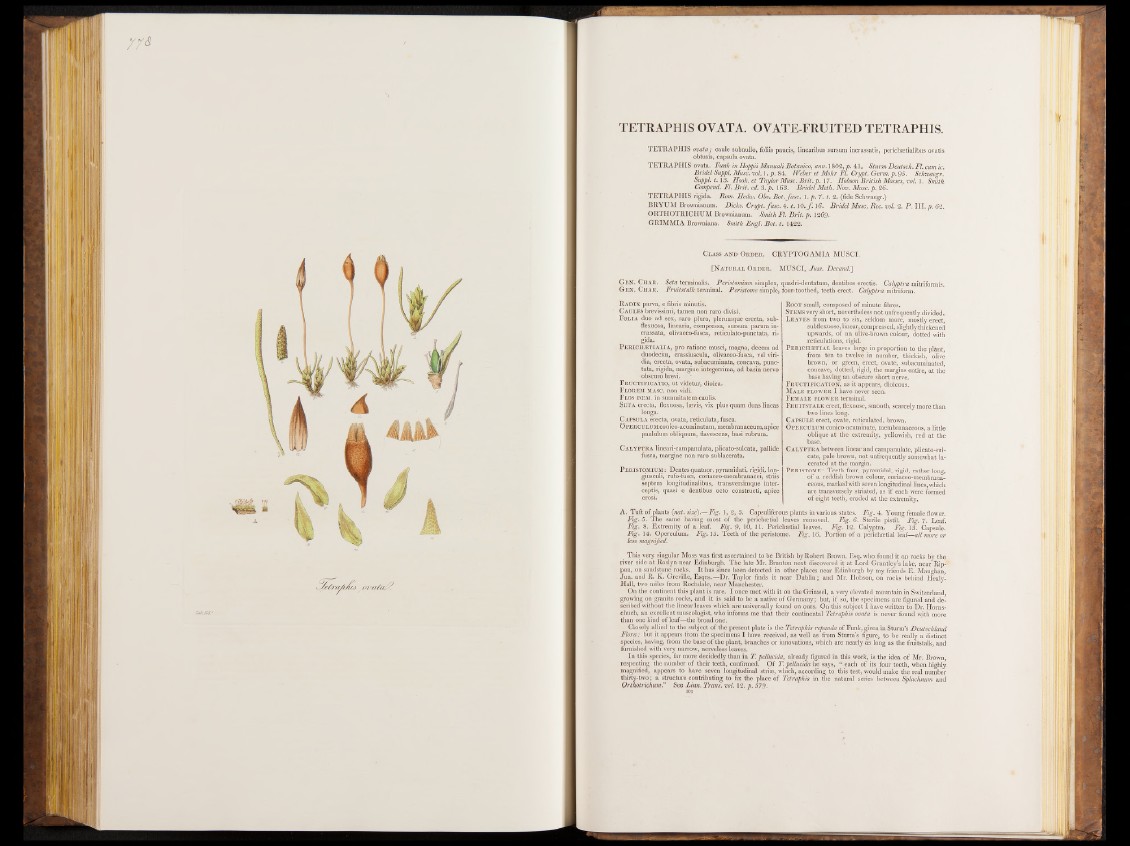
TETRAPHIS OYATA. OYATE-FRUITED TETRAPHIS.
T E TRAPHIS ovata; caule subnullo, foliis paucis, linearibus sursum incrassatis, perichtetialibus ovatis
obtusis, capsula ovata.
T E TRA PH IS ovata. Funk in Hoppii Manuali Bolanico, am . 1802, p. 41. Sturm Deutsch. F l. cum ic.
Bridel Suppl. Muse. ml. ]. p . 84. JVzber e t M ohr Fl. Crypt. Germ. p. 95. Schwaegr.
Suppl. 1. 13. Hook, et Taylor Muse. B r it.p . 17. Hobson B ritish Mosses, ml, 1. Smith
Compend. Fl. B r it. ed. 3. p . 163. Bridel Meth. N ov. Muse. p. 9,6.
T E T RA PH IS rigida. Rom. Hedro. Obs. Bot. fa s e . 1. p . 7. t. 2. (fide Schwaegr.)
BRYUM Brownianum. Dicks. Crypt, fa se . 4 . 1. 10. ƒ . 16. Bridel Muse. Ree. ml. 9. P . I I I . p. 62.
O R THOTRICHUM Brownianum. Smith Fl. B r it.p . 1269.
GRIM M IA Browniana. Smith Engl. Bot. t. 1422.
Class a n d Order. CRYPTOGAMIA MUSCI.
[N atural Order. MUSCI, Juss. Decand.}
Gen. Char. Seta terminalis. Peristomium simplex, quadri-dentatum, dentibus erectis. Calyptra mitriformis.
Ge n . Char. Fruitstalk terminal. Peristome simple, four-toothed, teeth erect. Calyptra mitriform.
Radix parva, e fibris minutis.
Caules brevissimi, tarnen non raro divisi.
Folia duo ad sex, raro plura, plerumque erecta, sub-
flexuosa, linearia, compressa, sursum parum in-
crassata, olivaceo-fusca, reticulato-punctata, ri-
gida.
Pe rickzetiali a, pro ratione musci, magna, decern ad
duodecim, crassiuscula, olivaceo-fusca, vel viri-
dia, erecta, ovata, subacuminata, concava, punctata,
rigida, margine integerrima, ad basin nervo
obscurobrevi. •
Fructificatio, ut videtur, dioica..
Florem masc. non vidi.
Flos fcem. in summitatem caulis.
Seta erecta, fiexuosa, las vis, vix plus quam duas lineas
longa.
Capsula erecta, ovata, reticulata, fusca.
Operculum conico-acuminatum, membranaceum, apice
paululum obliquum, flavescens, basi rubrum.
Calyptra lineari-campanulata, plicato-sulcata, pallide
fusca, margine non raro sublacerata.
Peristomium : Dentes quatuor, pyramidati, rigidi, lon-
giusculi, rufo-fusci, coriaceo-membranacei, striis
septem longitudinalibus, transversimque intercept]'
s, quasi e dentibus octo const rue ti, apice
.erosi.
Root small, composed of minute fibres.
Stems very short, nevertheless not unfrequently divided.
Leaves from two to six, seldom more, mostly erect,
subflexuose, linear, compressed, slightly thickened
upwards, of an olive-brown colour, dotted with
reticulations, rigid.
Perici-izetial leaves large in proportion to the plimt,
from ten to twelve in number, thickish, olive
brown, or green, erect, ovate, subacuminated,
. concave, dotted, rigid, the margins entire, at the
base having an obscure short nerve.
Fructification, as it appears, dioicous.
Male flower I have never seen.
Female flower terminal.
Fruitstalk erect, flexuose, smooth, scarcely more than
two lines long.
Capsule erect, ovate, reticulated, brown.
Operculum conico-acuminate, membranaceous, a little
oblique at the extremity, yellowish, red at the
base.
Calyptra between linear and campanulate, plicato-sul-
cate, pale brown, not unfrequently somewhat lacerated
at the margin.
Peristome : Teeth four, pyramidal, rigid, rather long,
of a reddish brown colour, coriaceo-membrana-
ceous, marked with seven longitudinal lines, which
are transversely striated, as if each were formed
of eight teeth, eroded at the extremity.
A. Tuft of plants (nat. size).—Fig. I, 2, 3. Capsuliferous plants in various states. Fig. 4. Young female flower.
Fig. 5. The same having most of the perichcetial leaves removed. Fig. 6. Sterile pistil. Fig. 7 . Leaf.
Fig. 8. Extremity of a leaf. Fig. 9, 10, 11. Pericheetial leaves. Fig. 12. Calyptra. Fig. 13. Capsule.
Fig. 14. Operculum. Fig. 15. Teeth of the peristome. Fig. 16. Portion of a perichietial leaf— all more or
less magnified.
This very singular Moss was first ascertained to be British by Robert Brown, Esq. who found it on rocks by the
river side at Roslyn near Edinburgh. The late Mr. Brunton next discovered it at Lord Grantley’s lake, near Rip-'
pon, on sandstone rocks. I t has since been detected in other places near Edinburgh by my friends E. Maughan,
Jun. and R. K. Greville, Esqrs.—Dr. Taylor finds it near Dublin; and Mr. Hobson, on rocks' behind Healy-
Hall, two miles from Rochdale, near Manchester.
On the continent this plant is rare. I once met with it on the Grimsel, a very elevated mountain in Switzerland,
growing on granite rocks, and it is said to be a native of Germany; but, if so, the specimens are figured and described
without the linear leaves which are universally found on ours. On this subject I have written to Dr. Horns-
chuch, an excellent museologist, who informs me that their continental Tetraphis ovata is never found with more
than one kind of leaf—the broad one.
Closely allied to the subject of the present plate is the Tetraphis repanda of Funk, given in Sturm’s Deutschland
Flora: but it appears from the specimens I have received, as well as from Sturm’s figure, to be really a distinct
species, having, from the base o f the plant, branches or innovations, which are nearly as long as the fruitstalk, and
furnished with very narrow, nerveless leaves.
In this species, far more decidedly than in T. pellucida, already figured in this work, is the idea of Mr. Brown,
respecting the number of their teeth, confirmed. O f T. pellucida he says, “ each of its four teeth, when highly
magnified, appears to have seven longitudinal strite, which, according to this test, would make the real number
thirty-two; a structure contributing to fix the place of Tetraphis in the natural series between Splachnum and
Orthotrichum." See Linn. Trans, vol. 12. p. 579.